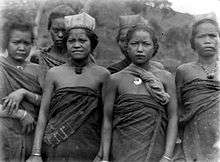Manggarai people
|
A Manggarai family. | |
| Total population | |
|---|---|
| (725,000[1]) | |
| Regions with significant populations | |
|
Indonesia: (Flores Island) East Nusa Tenggara | |
| Languages | |
| Manggarai language | |
| Religion | |
| Christianity (predominantly), Islam, Folk religion | |
| Related ethnic groups | |
| Lamaholot people |
The Manggarai are an ethnic group found in western Flores in the East Nusa Tenggara province, Indonesia. Manggarai people are spread across three districts in the province, namely the West Manggarai Regency, Manggarai Regency and East Manggarai Regency.
History
According to historical records, they have been occupied alternately by other tribes such as the Bima people from the island of Sumbawa and the Makassar people from Sulawesi island, Indonesia. As of the late 20th century, there are about 500,000 Manggarai people.[2]
Politics
Their political system is clan-based, led by a chief clan called Todo. This people practices patrilineal descent system, and historically they live in villages of which consists at least two clans.[2]
Culture

Rituals
The Manggarai people are known to have series of ritual as a thanksgiving for the life that has been given to them to live in a certain time period. Among others are:-[3]
- Penti Manggarai, a ceremony of harvest thanksgiving celebration.[4]
- Barong Lodok, a ritual that invites the guardian spirit to the center of Lingko (middle farm).[5]
- Barong Wae, a ritual to invite ancestral spirits to be a watcher over springs.[6]
- Barong Compang, a ceremony of summoning a village guardian spirit at night.[7]
- Wisi Loce, this ceremony is conducted so that all spirits who are invited are able to wait a moment before the climax of the Penti ceremony.
- Libur Kilo, a ceremony of thanksgiving for the welfare of each family in their homes.[8]
Fighting arts
Manggarai people also have a traditional folk sport and war dance called caci, a form of whip fighting where fighting and parrying each other using a whip and a shield is usually performed by two young men in a large field. Caci performance usually begins with Danding dance performances, before the caci warriors display their abilities to hit and parry in the competition. The dance is commonly referred to as Tandak Manggarai, a dance performed on stage to predict the outcome of the Caci competition.[3]
Language
The language spoken throughout the region is called Tombo Manggarai, a language with around 43 sub-dialects and it is a language that is very distinct from the languages of ethnic groups to the east and from Indonesian.[9]
References
- ↑ "Manggarai in Indonesia". Joshua Project. Retrieved 2015-01-17.
- 1 2 http://www.britannica.com/eb/article-9050522/Manggarai
- 1 2 "Etnis Manggarai, dari Ritual ke Ritual". Liputan6. Retrieved 2015-01-17.
- ↑ Maribeth Erb, Carol Faucher & Priyambudi Sulistiyanto (2013). Regionalism in Post-Suharto Indonesia. Routledge. ISBN 11-342-6380-5.
- ↑ Markus Makur (7 November 2014). I Made Asdhiana, ed. "Unik, Tradisi "Poka Kaba" di Lembah Kampung Bumbu". Kompas. Retrieved 2016-11-01.
- ↑ Markus Makur (5 May 2016). "Clean-up ritual a la Manggarai people". The Jakarta Post. Retrieved 2016-11-01.
- ↑ "Penti Weki Peso Beo, Ritus Pembersihan Dosa Kampung (Bagian II)". Berita Satu. 18 August 2012. Retrieved 2016-11-01.
- ↑ David Edison (1 April 2012). "Mengenal Upacara Penti dalam Budaya Manggarai". Kompasiana. Retrieved 2016-11-01.
- ↑ - Ethnologue: Manggarai
External links
- Joshua Project — Manggarai Ethnic People in all countries
- Manggarai Map — Satellite Images of Manggarai
| Wikimedia Commons has media related to Manggarai people. |
